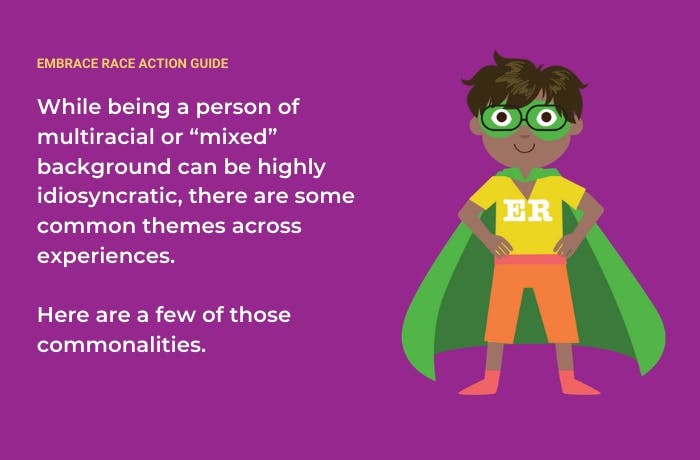5 Things to Know if You Love a Mixed-Race Kid
by Sara-Momii Roberts

While being a person of multiracial or “mixed” background can be highly idiosyncratic, there are some common
themes across experiences. Knowing some of these commonalities can provide support to parents, family members,
teachers and others who want to understand what mixed-kids in a racially obsessed society might go through.
These examples are drawn from my life and from my conversations with other racially mixed people over the years.
1. Racially mixed kids may be “read” differently depending on who they are around.
My eight year-old son is Guyanese, Japanese and white. Among his nearly all-white classmates, he’s perceived as a dark-skinned boy. The color he chooses for self-portraits drawn in school are always two or three shades darker than his actual skin color. On his all-black basketball team, he’s called the light-skinned team member. Among my husband’s Puerto Rican family members he looks Puerto Rican. Sitting next to me, it’s clear that he’s part Asian.
While my son can’t fully process these racial identity realities yet, this ambiguity, this fluidity, is a common experience among racially mixed people. To borrow from W.E.B. Du Bois’ notion of “double consciousness,” many racially mixed people learn to see themselves through their own eyes and through the eyes of others.
2. Mixed kids may look different over time and may need to actively assert all parts of themselves to others.
At birth, my son’s hair was dark and straight, his skin was light and his eyes were almond. Looking at my newborn son, my first thought was that I’d given birth to my late Japanese grandfather. Eight years later, my son’s hair is full of bouncy curls, his skin is caramel and his eyes are wide. Today his middle name is the most evident trait he shares with his great grandfather.
3. Mixed kids may be treated in ways inconsistent with the way they see themselves.
As a mixed race Japanese and white woman, my own features have changed over the years. In the first grade a white classmate confronted me at recess, pulled the outside corners of his eyes wide, and sang, Chinese, Japanese, Your Knees, My Knees. I thought to myself, why would he sing this to me? Are my eyes slanted? In retrospect, I did look Asian at the time, but I hadn’t developed an Asian identity then.
4. Mixed kids usually benefit from affinity group experiences.
An affinity group is a group of people who share a set of experiences, identities, or goals and meet to discuss them. As an educator who teaches about social justice and race-related issues, I’ve participated in many conferences about race over the years and had opportunities to be in mixed-race affinity groups. There is a powerful feeling of affirmation I experience in multiracial affinity groups that allows me to feel proud of who I am when connected with other mixed people. Kids who participate in supportive mixed-race affinity groups are also likely to feel pride and joy in who they are.
5. Maria P. Root’s “Bill of Rights for People of Mixed Race Descent,” or a version of it, can be affirming for mixed-race kids.
Maria P. Root is a multiracial clinical psychologist and educator who has written seminal work on multiracial identity. I was first introduced to her research at an event put on by a community group for multiracial Asians. Root has identified and validated the shared experiences of mixed race people through her research and created documents to empower us. Her “Bill of Rights for People of Mixed Race Descent” is one such document.
Sharing the Bill of Rights with my son and “translating” it into kid-friendly language and sentiments, making it his and our own, was an immensely helpful exercise. It might be helpful for your mixed-race kid too.
You can find Dr. Root’s original Bill of Rights for People of Mixed Race Descent here and our (shorter) version below:
Bill of Rights for Kids of Mixed Race Descent
- I have the right not to be bullied about who I am.
- I have the right to be what I say.
- I have the right to not be teased about who I am.
- I have the right to call myself what I want to call myself.
- I have the right to be friends with whoever I want.
- I have a right to look differently than my sisters or brothers, and that’s okay.
Sara-Momii Roberts



